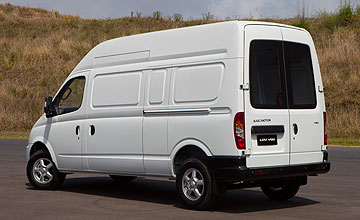BY RON HAMMERTON | 25th Feb 2015

Even Porsche’s iconic 911 has a 95 per cent take-up of automatic versus manual, firmly underscoring just how far autos have become the norm.
The situation is less clear cut in the commercial vehicle realm, but nevertheless, many professional drivers and tradies who spend a good part of the day in the urban traffic slog might value any aid that eases the drudge.
In the case of the British-designed, Chinese-made LDV van range that was launched here in 2013, customers could have any transmission they wanted as long as it was a five-speed manual. Until now, that is.
Effectively re-launched by distributor Ateco Automotive since it took over the franchise last year, the V80 now has a $2000 automatic alternative in all variants – sort of.
Like several other vans from European rivals such as Fiat and Renault, the V80’s new six-speed transmission from Italy’s Magneti Marelli is an automated manual, meaning it operates with a normal plate clutch rather than a fluid torque converter.
But rather than depress a clutch pedal by foot, the gearbox operates the clutch with an actuator of its own accord.
Among the benefits are the driveline efficiency of a standard manual – no torque losses in the fluid drive – and less weight than a conventional auto.
And it is strong too – important on a load-bearing vehicle.
A downside is that gear changes are not as slick as a normal auto, feeling uncannily like a manual gearbox with a distinct pause as the robot operates the clutch and shifts gears while backing off the gas as the driver waits for the resumption of forward propulsion.
To speed things up a little, the driver can shift the gears manually via the dash-mounted sequential lever, although it still takes a little time for the box to follow through. We suspect Magneti Marelli – supplier of Formula 1 sequential transmissions – does not supply the same slam-bam shift mechanism to LDV as it does to Ferrari Racing.
Still, when driving the automated manual van back-to-back with the manual equivalent, the benefit of not having to depress the rather heavy clutch pedal with every gear change is apparent.
When parking the auto V80, the driver needs to be careful to pull on the handbrake lever because the automated gearbox has no ‘park’ function, meaning it has a tendency to roll away on the unwary.
A ‘mode’ button next to the gear lever adds a sportier gear function, meaning the robot lets the diesel engine rev out more before intervening with clutch and a higher cog.
As diesels – including this 100kW/330Nm 2.5-litre four-cylinder turbo unit from Italy’s VM Motori – tend to do their best work in the torquey mid range, it seems a little unnecessary.
However, we did not drive the V80 with a load, nor on steep hills, so maybe that is where it comes into play.
The engine pulls willingly if noisily, which is standard fare for VM Motori diesels we have sampled in other vehicles, including various Holdens.
Claimed fuel consumption is good at 8.9 litres per 100km, although we did not get to test this in our short test drive around Sydney’s Olympic Park area at Homebush.
Because the V80 was designed and engineered in Britain by LDV before the Chinese got involved when the company hit the financial wall in the global financial crisis, it is designed to go head to head with myriad similar commercial vans from Europe’s biggest motor companies, ranging from Ford to Mercedes-Benz.
The big difference is that the LDV is now made in China and thus comes from a lower labour cost base and shorter supply chain.
Starting at $29,990 driveaway for the short-wheelbase manual, the V80 is about $6000-8000 cheaper than similar-sized diesel goods vans capable of swallowing two standard-sized load pallets and a payload of up to 1480kg.
Two long-wheelbase variants – one with mid-height roof and the other with a high roof, are also available, as well as too newly introduced commuter passenger bus variants with 11 and 14 seats.
Standard equipment in the goods vans is reasonably high, with manual air-conditioning, cruise control, MP3-compliant audio system, seating for three across the cabin, dual side sliding doors and rear barn doors that open wide to 180 degrees.
But Bluetooth appears to be missing from the features list, which is a blunder.
After all, such vans constitute a work place with safety rules.
The instrument binnacle mounted in the middle of the dash, away from the driver’s vision, means the speedo is awkward to see, too.
The V80 has driver and passenger airbags, but no head-protecting side airbags – unfortunately a common omission in large commercial vehicles.
The big question mark over all Chinese vehicles is the assembly line execution.
On our drive day, Ateco had about eight vehicles for us to sample, and all seemed to have good quality paint (any colour you like as long as it is white), doors that shut cleanly and neat seams.
A dash-top rubber mat lining a tray for pens, phones and the like seemed a little ill fitting, but by and large the quality seemed adequate.
However, the cabin design is a tad bare and plasticky compared with most European rivals, and with the exception of large door bins, could do with more storage space for small items.
Still, the LDV V80 is a classic case of you get what you pay for. If you are seeking a van with a European heart and a Chinese price tag for a cost-effective business operation, then maybe this should be on your list.